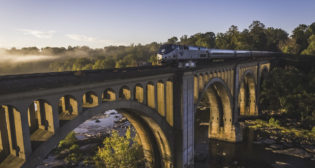
Re-inventing the DOT 111
Written by William C. Vantuono, Editor-in-ChiefRailcar suppliers gear up to meet demand for safety-first tank cars.
For tank car builders—American Railcar Industries, The Greenbrier Cos., National Steel Car, Texana Tank Car, Trinity Industries, Union Tank Car—the business outlook for the next five years is good, as demand for tank cars continues to surpass builder capacity. The RSI’s year-end 2013 report showed deliveries of 28,996 tank cars, and a backlog of 55,386. With builder capacity expected to be approximately 30,000 cars per year, this backlog will take close to two years to fill.
The tank car building boom is tempered by a regulatory climate in which new safety standards are the subject of intense discussion among railroads, carbuilders, lessors, and oil producers. Following several serious accidents involving crude oil trains, as well as the discovery that crude oil from Bakken shale deposits extracted by hydraulic fracturing is particularly volatile, the PHMSA, FRA, and Transport Canada are expected to impose new standards for DOT 111 (AAR 211) non-pressurized tank cars handling hazardous materials, specifically those transporting Class 3 PG (Packing Group) I and II denatured ethanol and crude oil. That’s not expected to happen until 2015, despite calls by politicians to speed up the usually lengthy federal rulemaking process.
The industry has not waited for a rulemaking to manufacture stronger tank cars. Since October 2011, well before the CBR (crude by rail) boom started, all DOT 111s have been built far sturdier than their predecessors.
The AAR, with support from the RSI Committee on Tank Cars (RSICTC), in March 2011 submitted to PHMSA Petition 1577 to amend 49 C.F.R. Part 179 for tank cars used to transport PG I and II hazmat. P-1577 included both a jacketed and a non-jacketed option for new tank car construction. DOT 111s built since October 2011—so-called “good-faith cars”—have head shields, top-fitting rollover protection, half-inch-thick normalized tank steel (for unjacketed applications), double-shelf couplers, and bottom skid protection.
Currently, there are approximately 272,000 DOT 111s in the North American fleet. Of these, about 171,000 (63%) handle hazmat. Roughly 29,000 (17%) meet P-1577 standards, which AAR implemented as CPC (Casualty Prevention Circular) 1232.
Now, the AAR and RSICTC each have proposals in response to a PHMSA Advance Notice of Proposed Rulemaking that would make the current voluntary P-1577 standards law, presumably improve upon those standards, and set a time-frame for the phase-out or retrofitting of pre-P-1577 DOT 111s. The proposals are similar, but there are some key differences based on ownership and car utilization.
The AAR Tank Car Committee on Jan. 22, 2014 proposed tougher standards for new non-pressurized tank cars, plus retrofitting of P-1577 cars: 9/16-inch-thick TC128 Grade B steel shell and head, an 11-gauge outer steel jacket around the tank with thermal protection in the form of a protective blanket or equivalent protective layer, full-height half-inch-thick head shields, high-flow-capacity pressure relief valves, and design modifications (removal of the operating handle or system) to prevent bottom outlets from opening in the case of an accident. AAR was expected to amend an earlier proposal to PHMSA to reflect its new position.
The RSICTC issued a proposal to PHMSA on Dec. 5, 2013 that continues P-1577 standards for newly constructed DOT-111s transporting Class 3 PG I and II materials, with some key enhancements: tank cars constructed to 286,000-pound GRL (gross rail load) standards, heads and shells made of normalized steel, and, at minimum, half-inch-thick half-head shields. For tank cars constructed of normalized TC128 Grade B steel, head and shell thickness must be one-half-inch for non-jacketed cars, and 7/16-inch for jacketed cars. For cars constructed of normalized A516-70 steel, shells of non-jacketed cars must be 9/16-inch thick, while shells of jacketed cars must be a half-inch thick. Top fittings must be protected by a protective structure as tall as the tallest fitting. Finally, the RSICTC recommends installation of a reclosing pressure relief valve.
The RSICTC also supports reclassifying denatured ethanol and crude oil grades that are currently classified as PG III to PG I or II.
The RSICTC has urged PHMSA “to adopt a separate approach for existing tank cars that is uniquely tailored to the needs of the existing DOT 111 fleet. Because the industry voluntarily adopted the CPC-1232 standard, a significant number of DOT 111s are already compliant with P-1577 enhancements. Many builders and shippers have already made a significant capital investment in these cars. More than 55,000 CPC-1232-compliant tank cars will be in service by the end of 2015, representing an industry investment in excess of $7 billion.
In light of the industry’s proactive decision to incorporate these new safety enhancements, RSICTC requests that PHMSA recognize that these cars already contain safety enhancements and thus exempt them from any additional modifications that may be required under the future rule.”
What about the 140,000-plus non-P-1577 DOT 111s? The AAR has recommended that all such cars in hazmat service be phased out (retired, or repurposed to carry non-hazardous materials) or retrofitted. The AAR previously opposed retrofitting, saying it would cost the industry more than $1 billion, but there are many cars whose service life won’t expire for many years. There are about 75,000 of these newer yet non-P-1577 DOT 111s that are candidates for retrofitting; the cost is estimated at $20,000 to $40,000 per car.
What is a realistic time frame for retrofit or retirement of older cars? How long before the DOT 111 fleet is up to specs (whatever those will be)? “We have deferred to PHMSA to make this determination,” AAR told Railway Age. “The goal is for these improvements to be implemented as aggressively as possible, without curbing the industry’s ability to serve energy sector customers and support North American progress toward energy independence. RSI and others had specific timeline proposals, to which we did respond as we believe this ultimately must be decided by PHMSA.”
The NTSB estimates that 69% of today’s tank car fleet has a high incidence of tank failure during accidents. For cars transporting Bakken crude, corrosion problems are a concern. The Volatile chemicals in the oil (hydrogen sulfide, etc.) are likely accelerating the corrosion. Crude oil composition varies by region, and even within regions, making documentation of loaded crude oil, now under intense scrutiny, problematic. Corrosion-resistant tank linings are one solution, but they may render CBR less competitive due to the high cost of a lining—$7,000 to $10,000 per car—and the resulting reduction in tank capacity and higher transportation cost.
The industry watches—and waits—for regulatory bodies to decide exactly what the rules will be.



